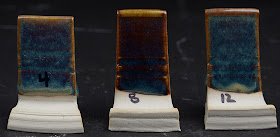 |
| Photo 1 |
In Photo 1, above, tile #13 shows the glaze with no colorants. Tile #1 has 0% iron, 1% rutile. Tile #5 has 1% iron, 0% rutile. Tile #9 has one percent of each.
 |
| Photo 2 |
In Photo 2, above, tile #2 has 1% iron oxide, 2% rutile. Tile #6 has 2% iron, 1% rutile. Tile #10 has 2% rutile, 2% iron.
 |
| Photo 3 |
In Photo 3, above, tile #5 (left) has 2% iron, 3% rutile. Tile #7 (center) has 3% iron, 2% rutile. Tile #11 (right) has 3% iron, 3% rutile. Tile #11 is not runny, the tile was dipped a little more than it should have been.
 |
| Photo 4 |
In Photo 4, above, tile #4 (left) has 3% iron, 4% rutile. Tile #8 (center) has 4% iron, 3% rutile. Tile #12 has 4% rutile, 4% iron.
Notes: You can clearly see crazing in the glass (not so good) with the smaller percentages of rutile and iron. However, at the 4% iron 4% rutile, I detect no crazing (good). I attribute this to the fluxing actions of the iron/rutile.
Test tiles are porcelain, fired to cone 10 in reduction.
I will update this test with higher amounts of iron/rutile at some point in the future.

So what are you using as a base glaze?
ReplyDelete